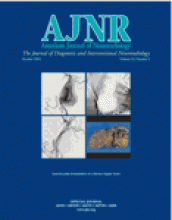After reading Dr. Ross’s editorial “The High-Field-Strength Curmudgeon” (1) in the February 2004 issue of the AJNR and the two letters by Shapiro et al and Tanenbaum in response to it in the current issue, I have concluded that the editorial and two letters made valid points about clinical use of 3T MR imaging systems on the basis of each individual experience. Manufacturers have made advances in software and hardware development to improve image quality and reduce imaging times, but one has to be very careful when using the 3T system in a clinical setting to avoid compromising image quality. To illustrate my point, let us assume that, all else being equal, there is an approximately 60% improvement in signal-to-noise ratio at 3T over 1.5T. In this editorial, I will discuss how one can alter imaging parameters at 3T to a point at which the signal-to-noise ratio in the image is lower than that at 1.5T.
Both the editorial and the two letters mentioned that the chemical shift artifacts are worse at 3T, and this is a particular problem with T2-weighted fast spin-echo (FSE) imaging. The chemical shift frequency between water and fat is doubled at 3T, so to reduce these artifacts to the level of 1.5T, one has to double the receiver bandwidth at 3T, which will reduce the signal-to-noise ratio by approximately 40%. If all other imaging parameters are unchanged, images obtained at 3T will therefore have a 20% better signal-to-noise ratio compared with that obtained at 1.5T. If one then tries to improve spatial resolution by increasing the in-plane matrix, decreasing the section thickness at 3T, or both, it will lead to further degradation in signal-to-noise ratio. There are other alternatives to reducing chemical shift artifacts at 3T without degrading image quality; one alternative is to use fat saturation, but this will further reduce the number of sections one can acquire, because of an increase in specific absorption rate (SAR). Another approach is to use water excitation, which does not significantly increase SAR and will improve image resolution and maintain signal-to-noise ratio that is similar to that at 1.5T. There are other alternatives to acquiring high-spatial-resolution images by using 3D methods, but not all manufacturers have developed 3D acquisition methods; an issue mentioned in one of the letters concerning 3D T2-weighted FSE sequences. Other modifications that the manufacturers and researchers are making to reduce radio-frequency deposition are to modify the FSE sequences by varying the refocusing flip angles (TRAPS and hyperechos). This was mentioned in one of the letters, but these methods are not available by all manufacturers.
As far as the coils are concerned, the phased-array head coil improves the image quality significantly compared with that with the quadrature coil and enables one to use parallel imaging methods that reduce imaging time. However, it also has a deleterious effect on signal-to-noise ratios. Hence, one needs to be careful about how much spatial resolution can be increased in conjunction with parallel imaging factors. At 3T, the phased-array coils have limited sensitivity; this is particularly noticeable in head coils, where one observes lower signal intensity at the center of the coil compared with periphery. Similarly, the coil sensitivity is not as good in the cervical, thoracic, and lumbar phased-array coils at 3T as compared with at 1.5T. The manufacturers are at various stages of coil development, be it quadrature or phased-array coils, and not all the coils are available through the manufacturers. Independent coil manufacturing companies do provide additional coils that do not come with the system, but this represents an additional expense to the user.
In summary, 3T systems have their advantages and disadvantages. There is inherent improvement in the signal-to-noise ratio, but that does not mean that one can provide very high-spatial-resolution images with shorter acquisition times without degrading the image quality below what one gets with 1.5T. This is a major pitfall when one initially starts using a 3T system with high expectations of markedly improved image quality. There is a learning curve one needs to navigate. This is not one sided, because manufacturers are also going through the growing pains with customers’ demands for better image quality and lower total acquisition times.
References
- Copyright © American Society of Neuroradiology












